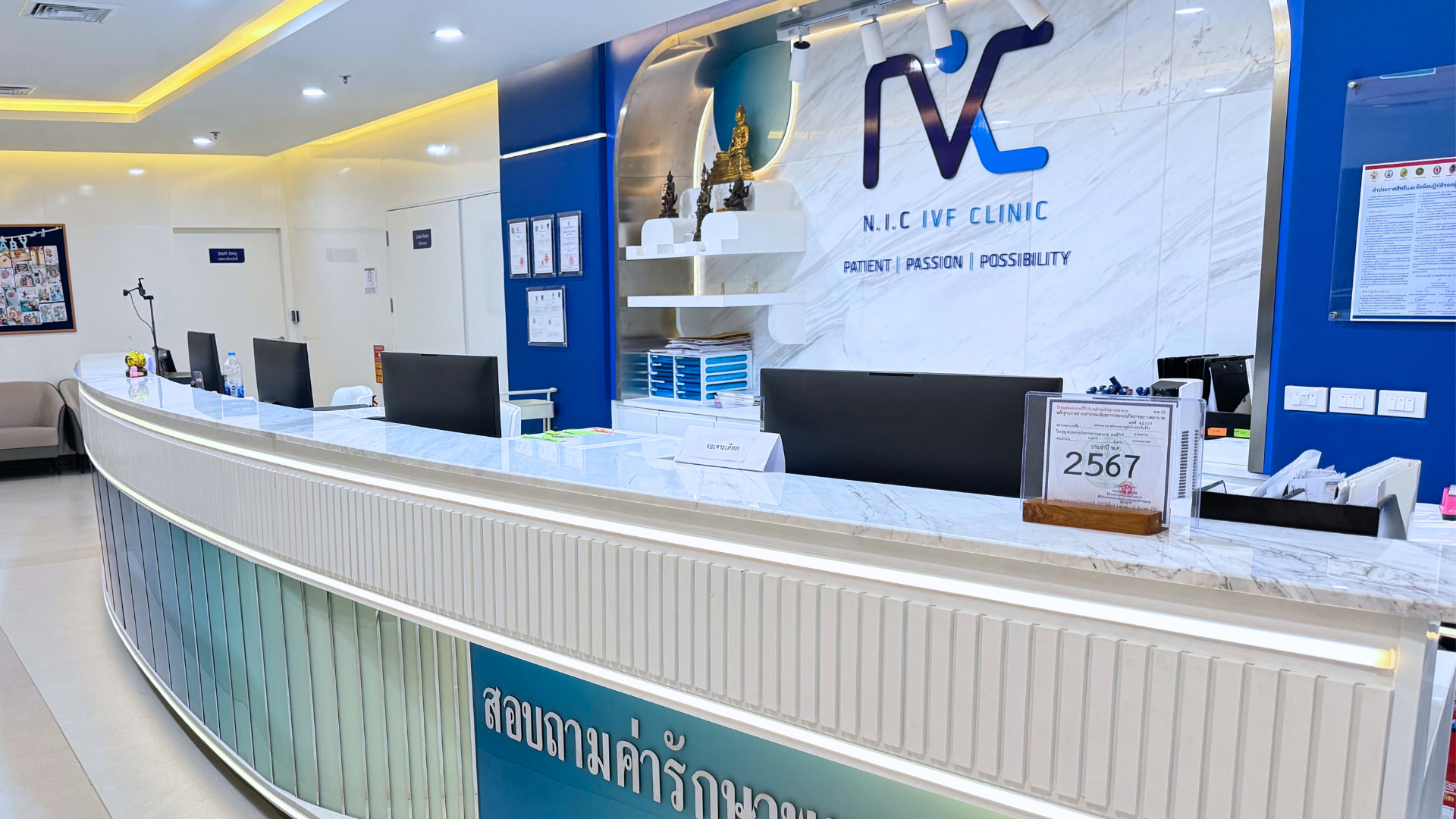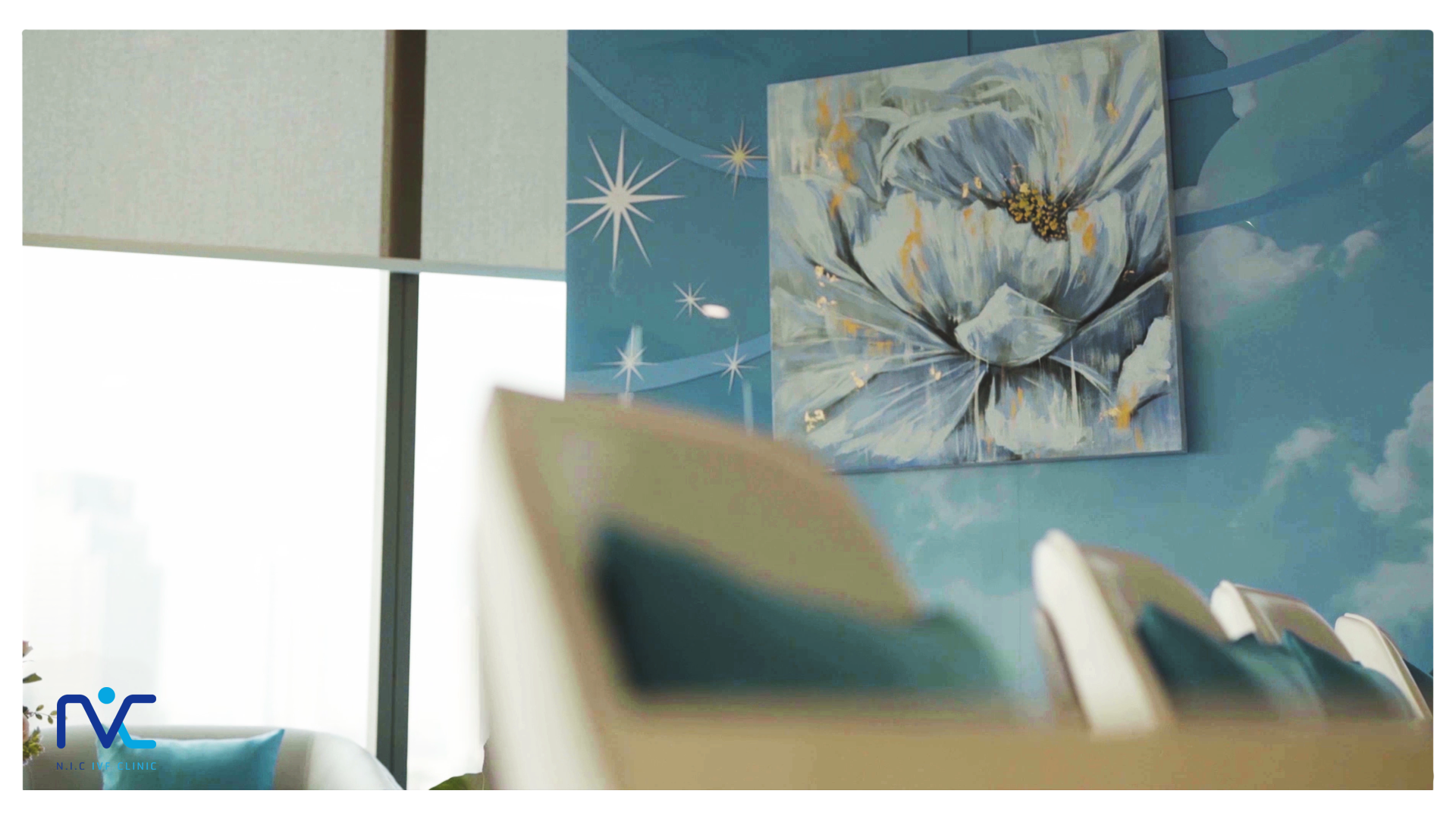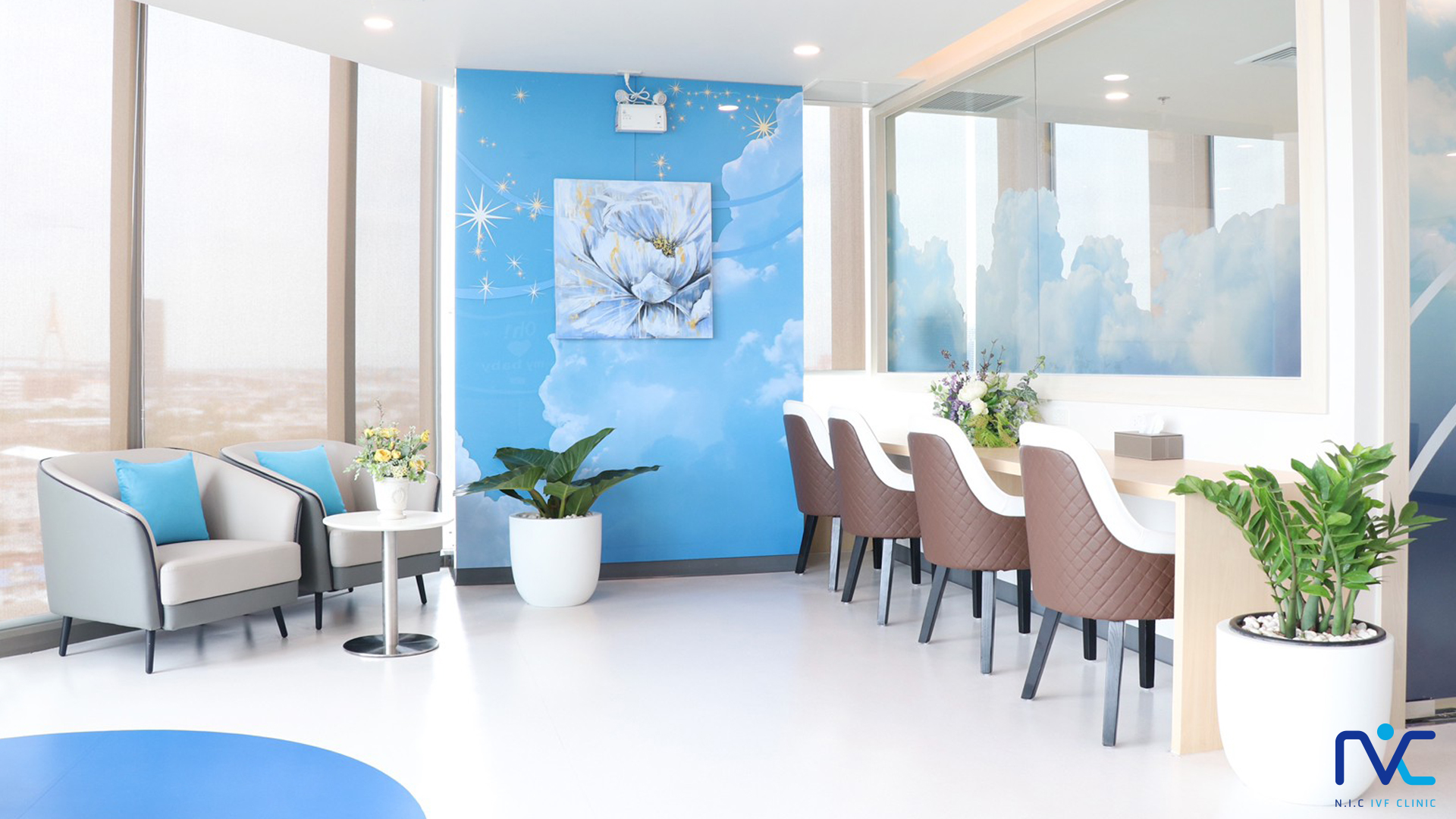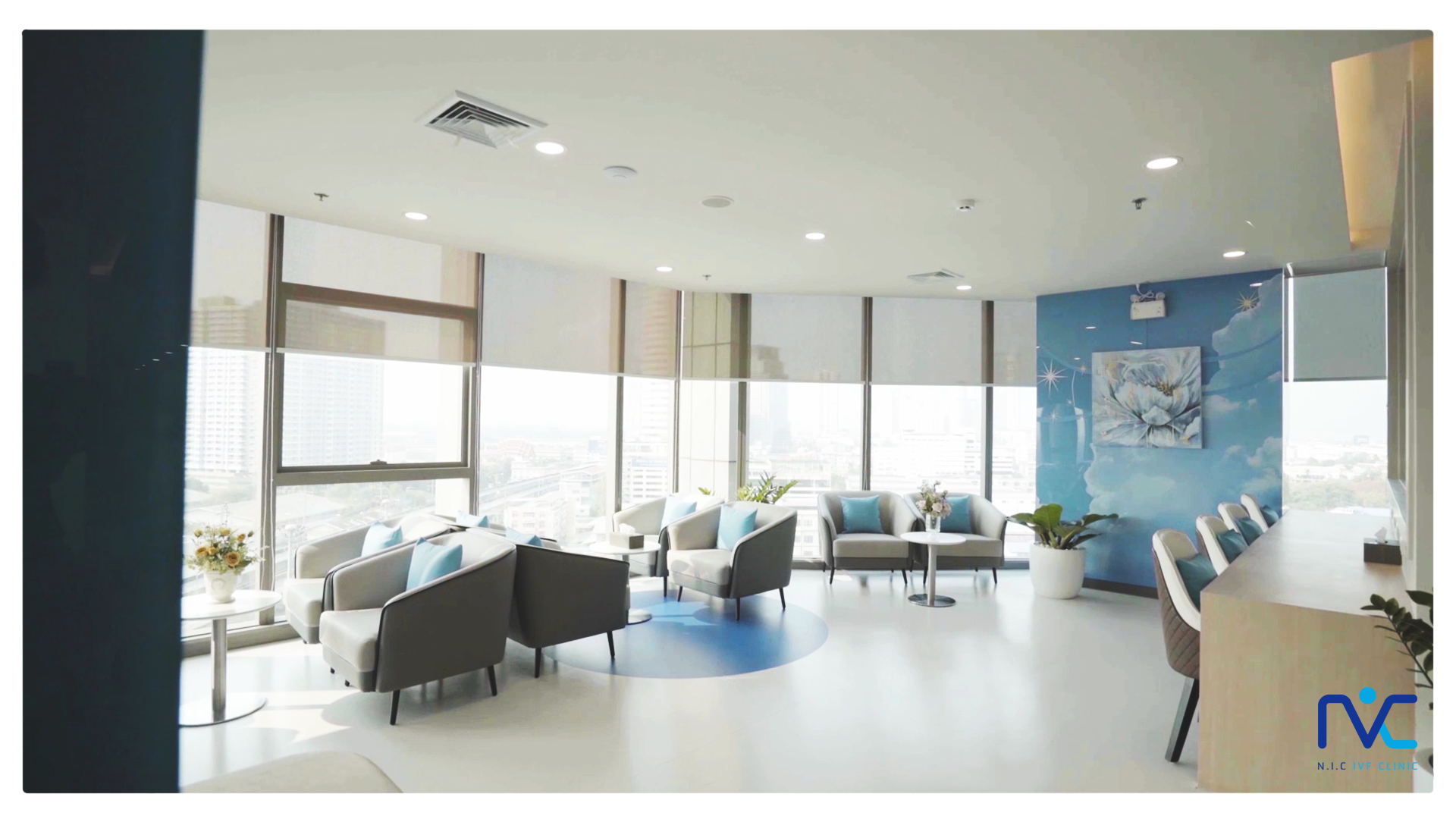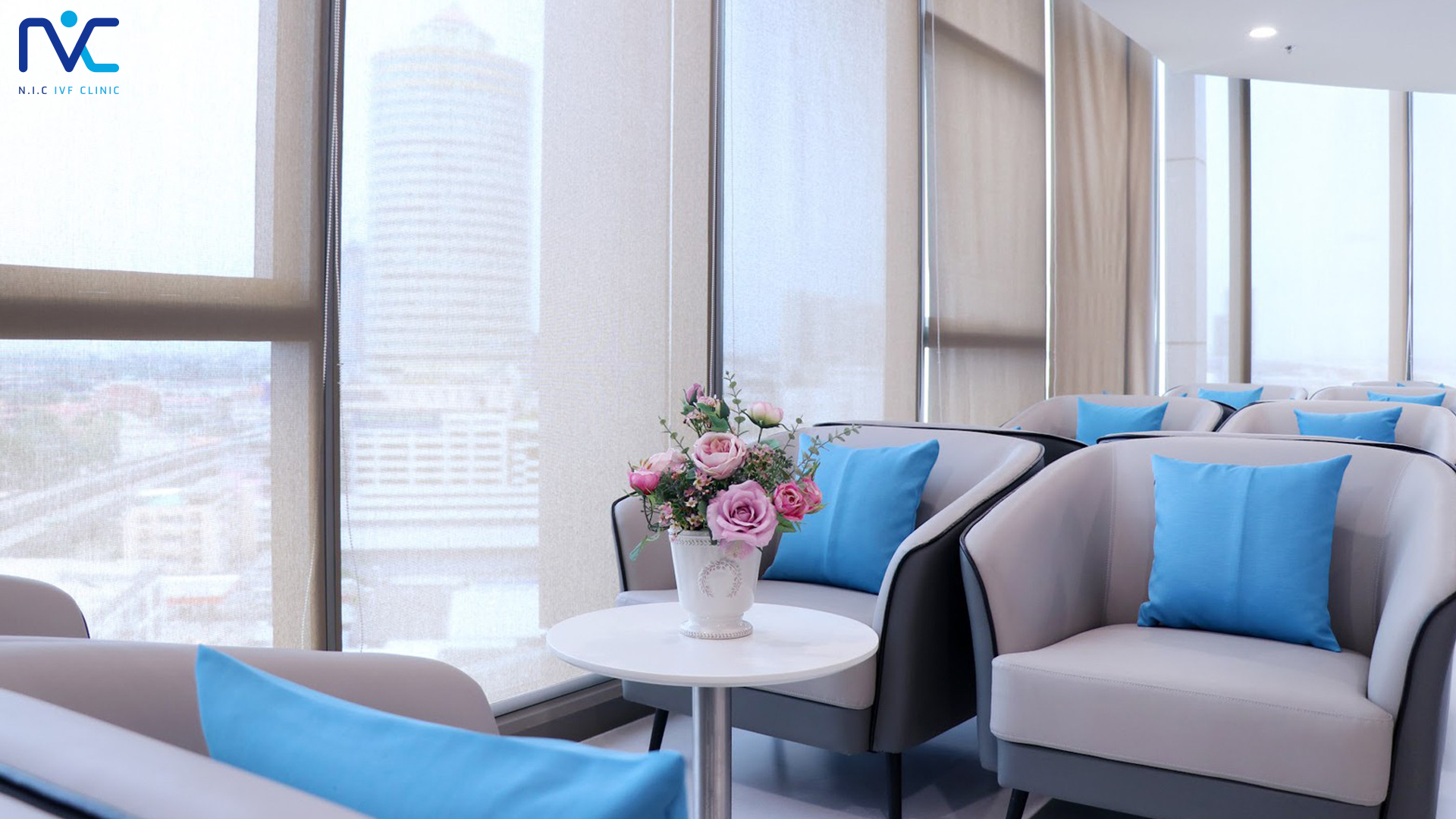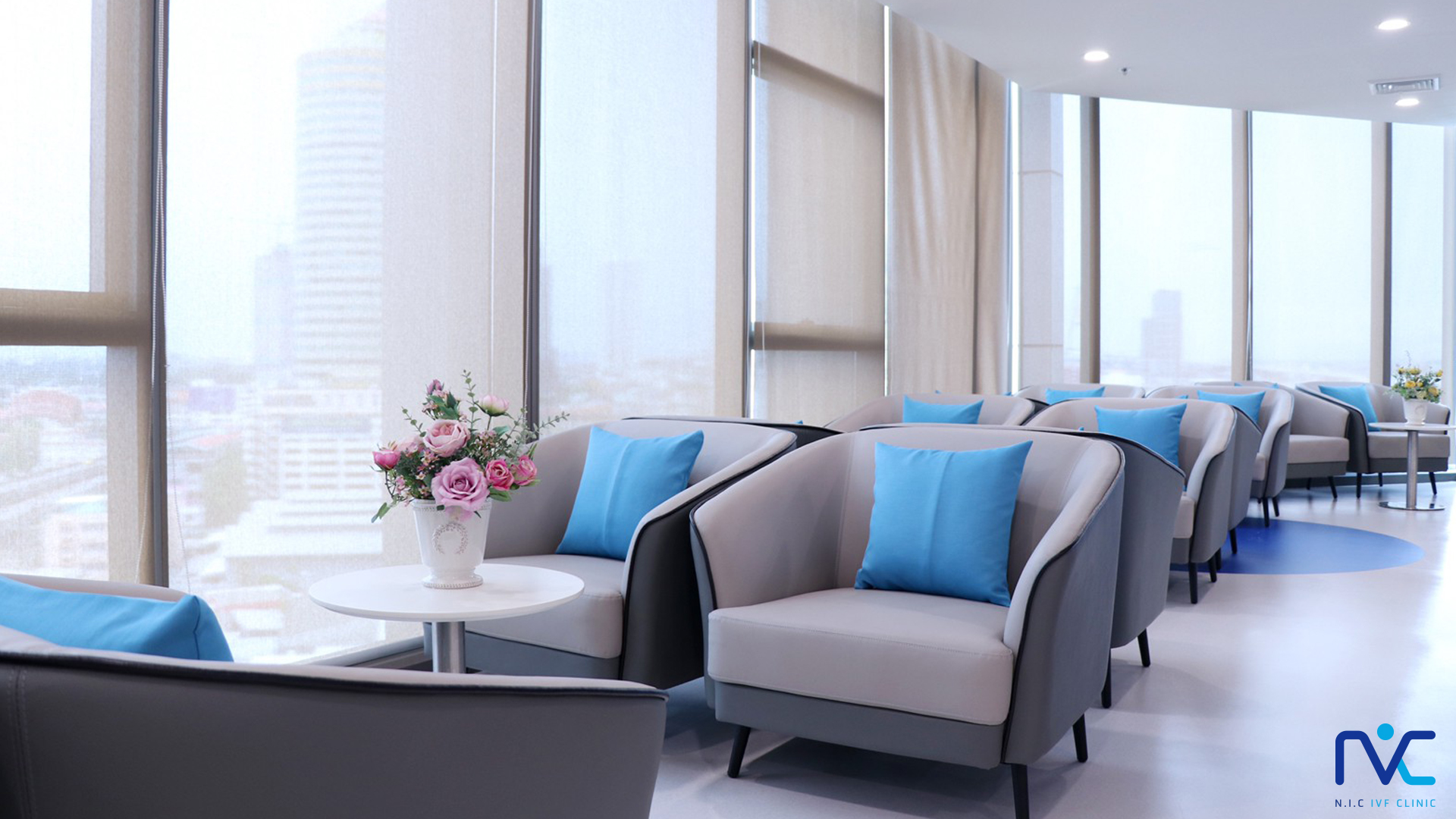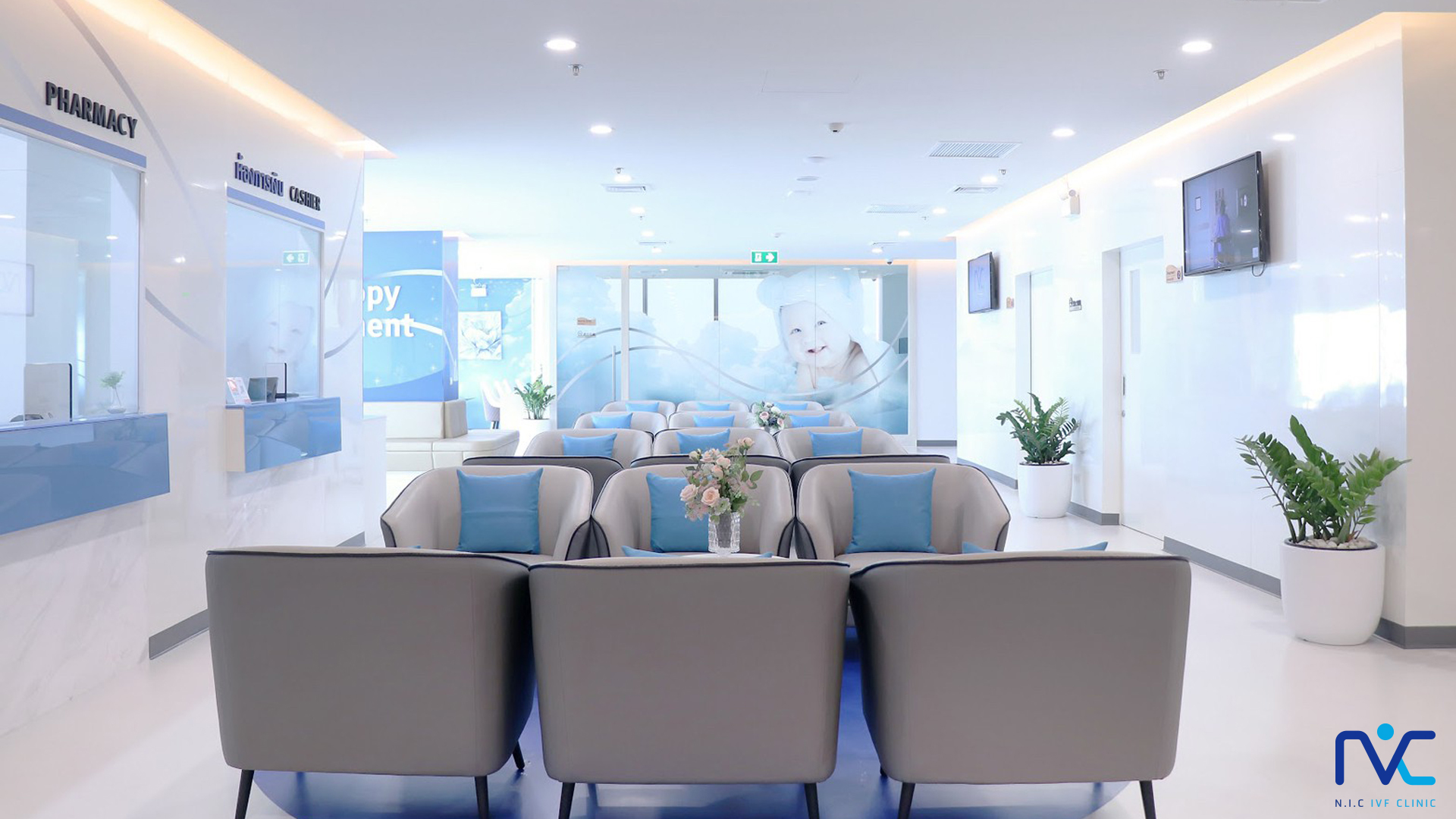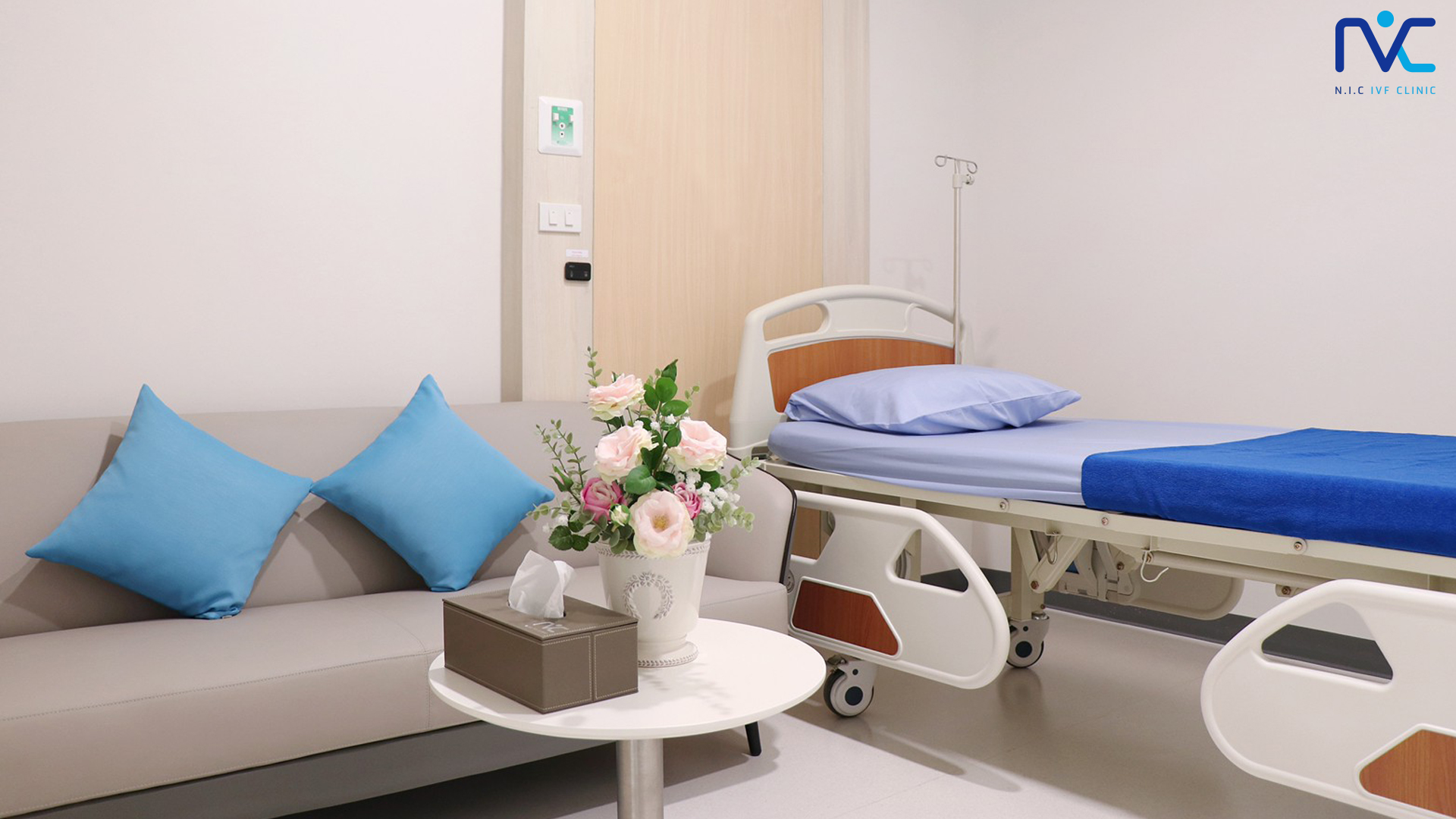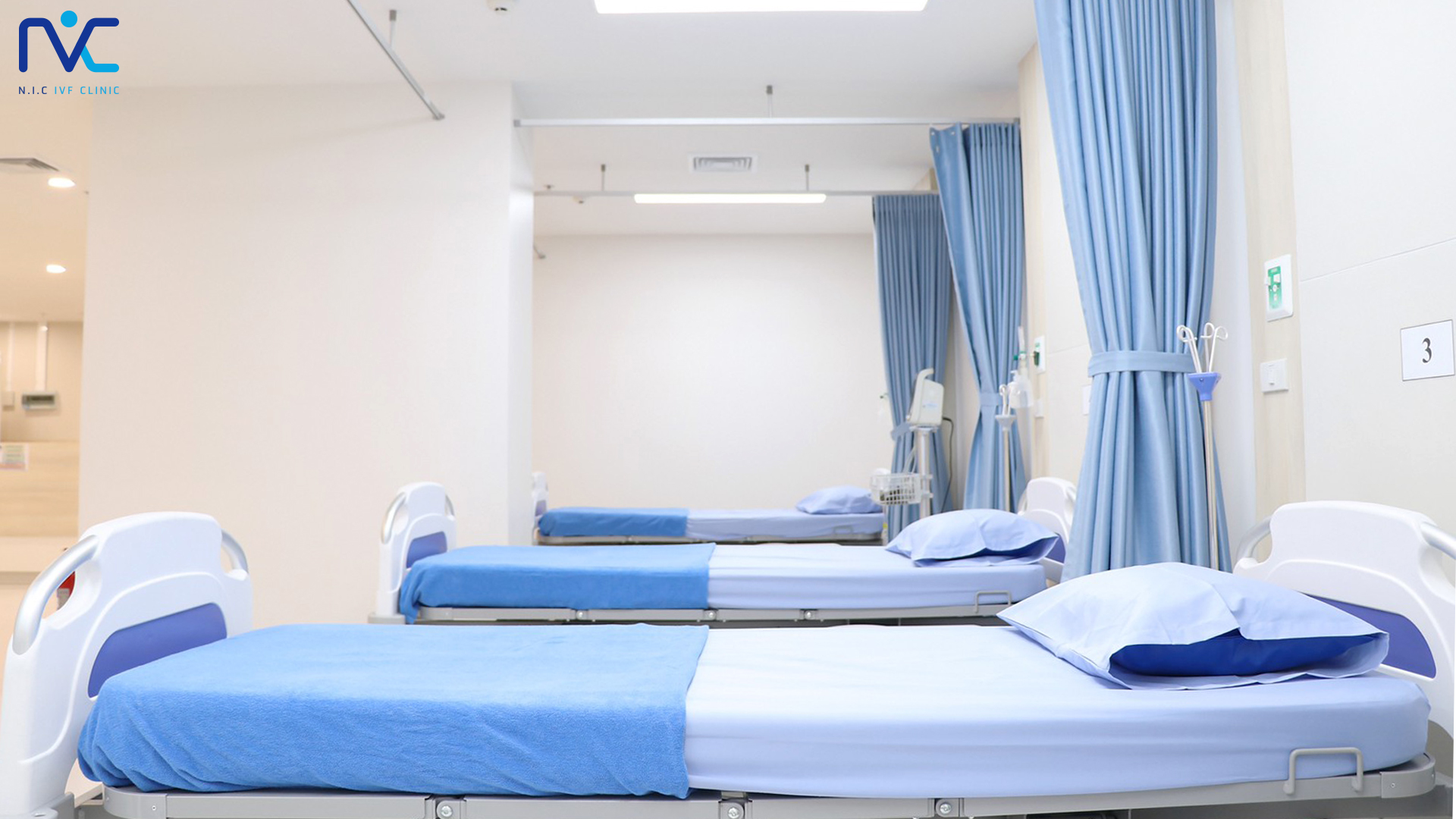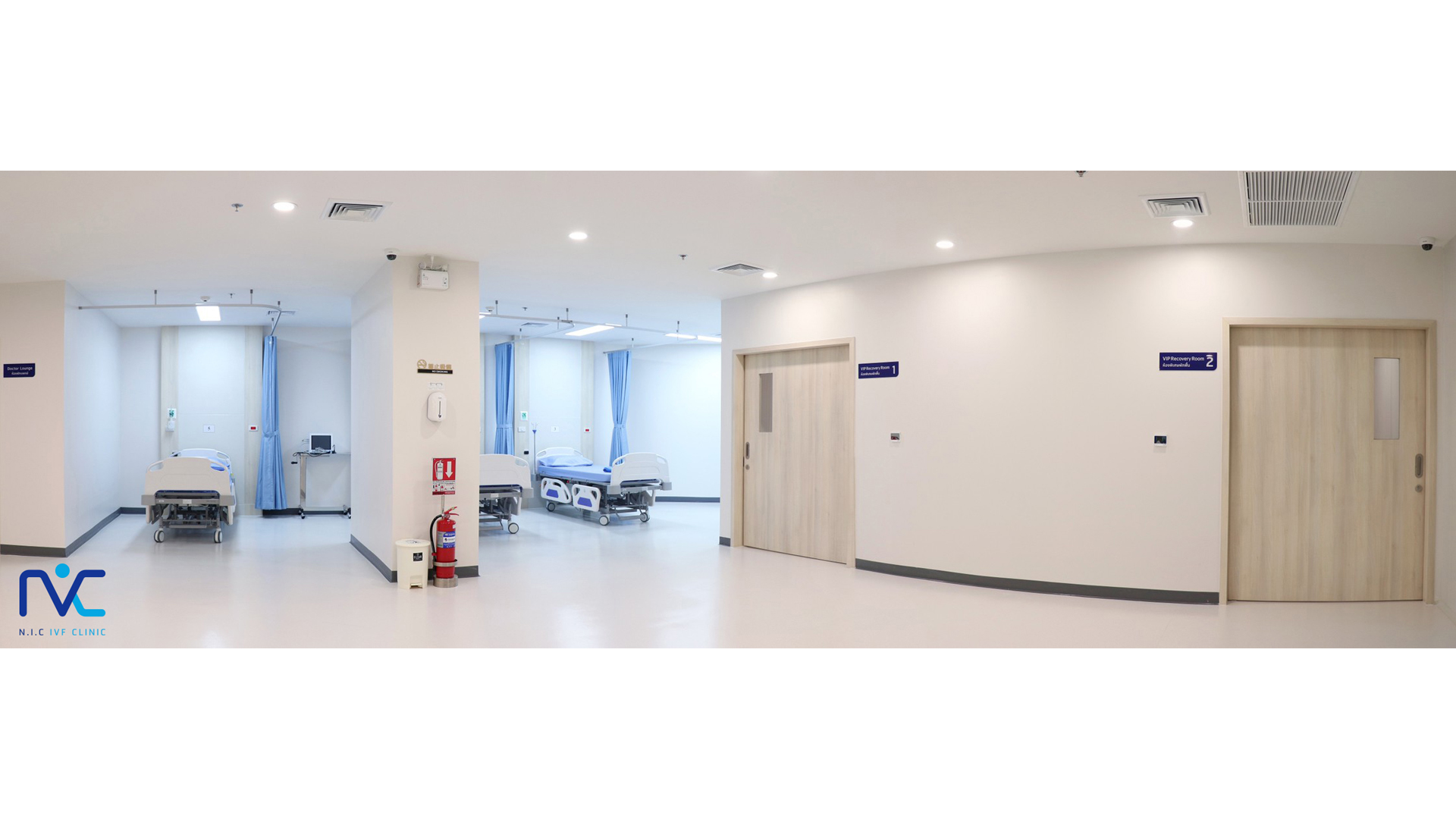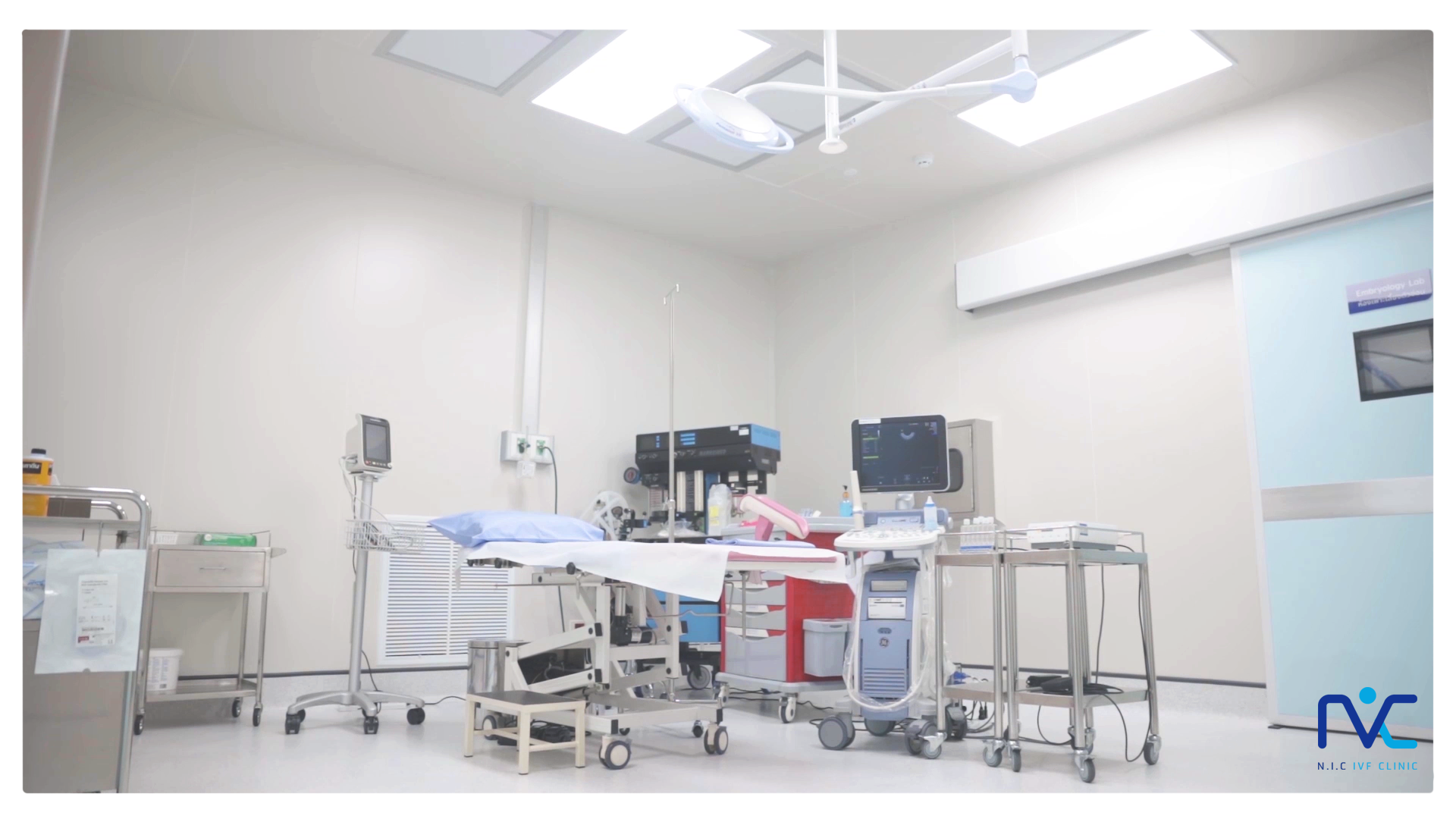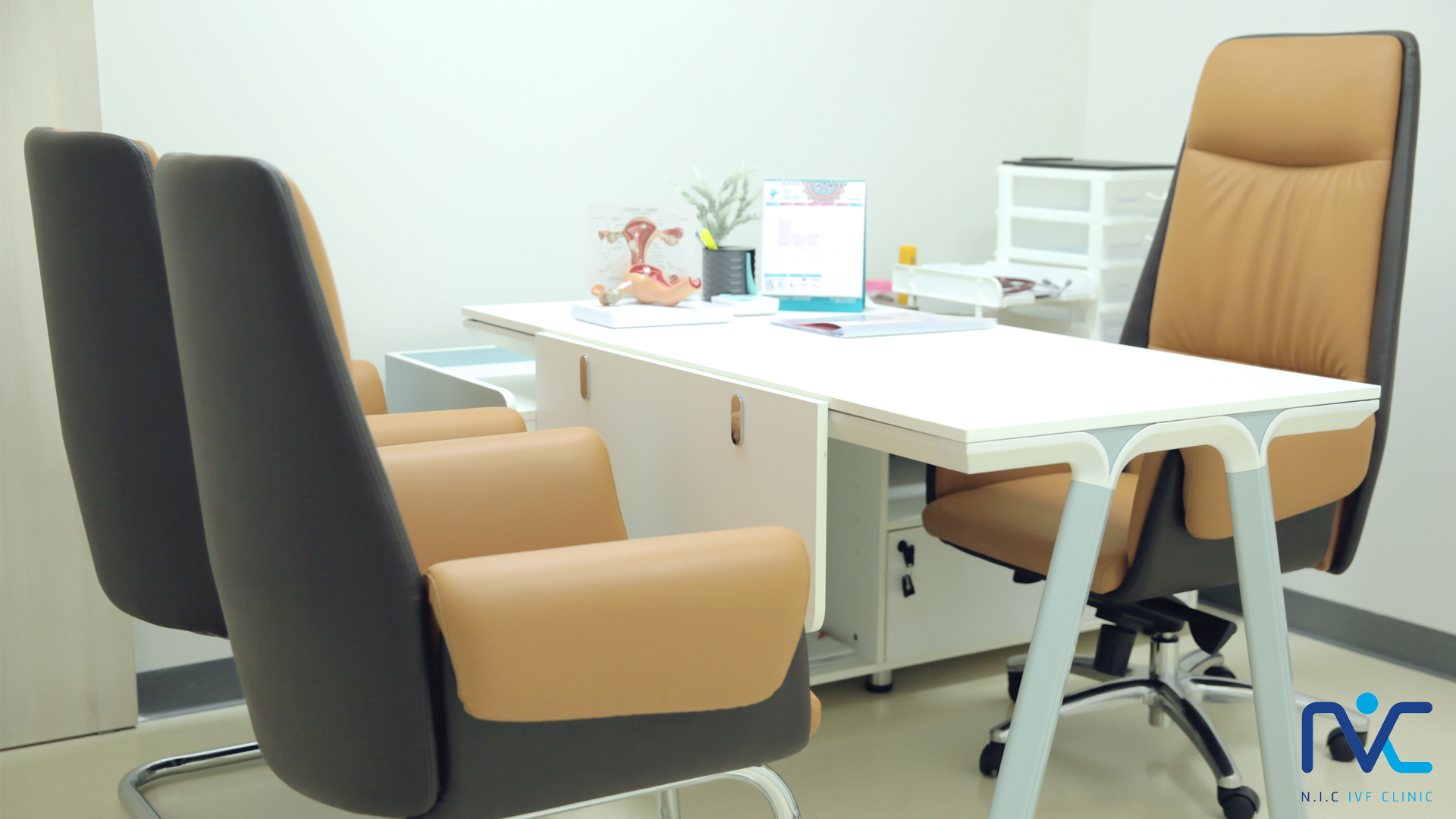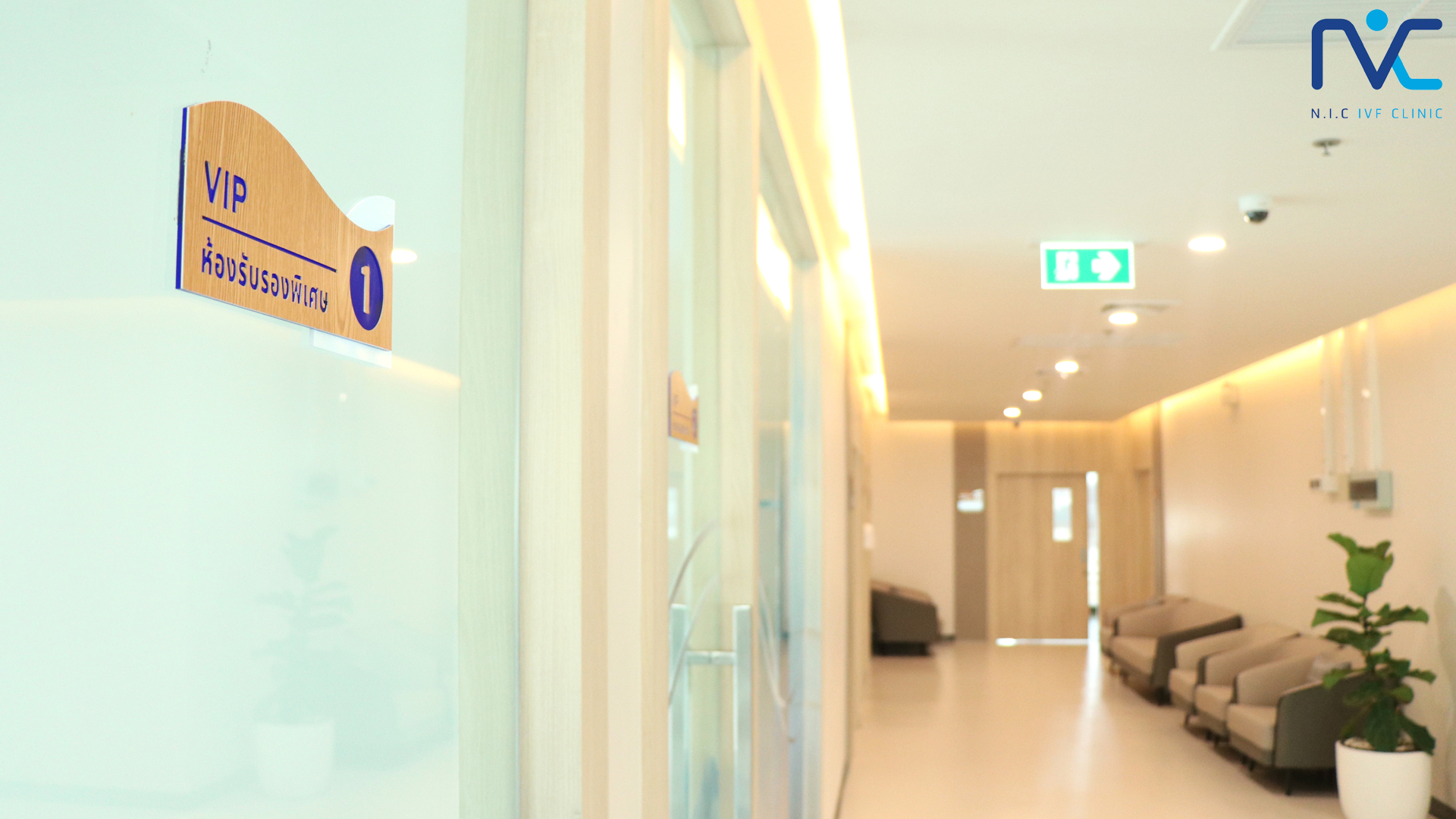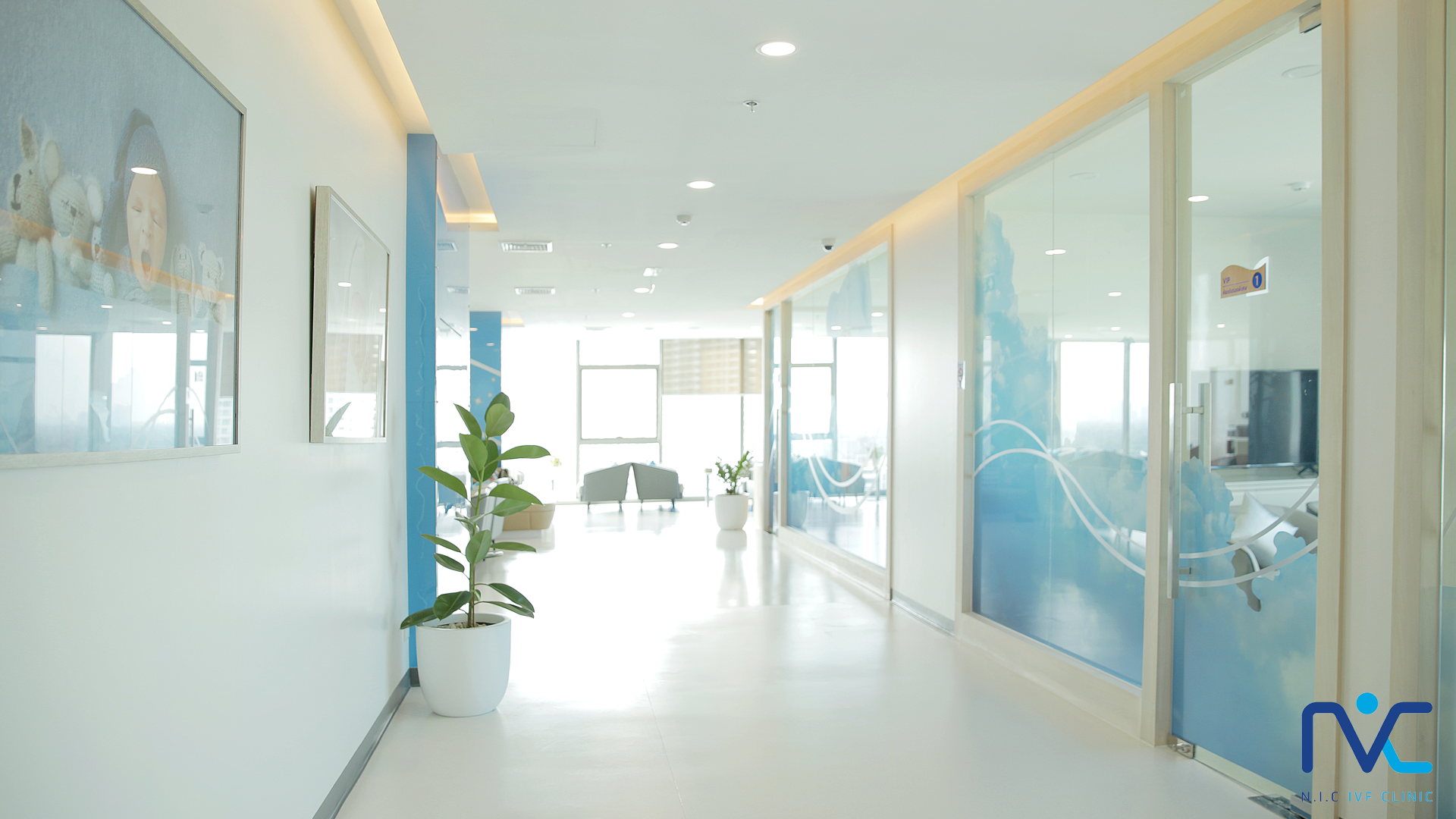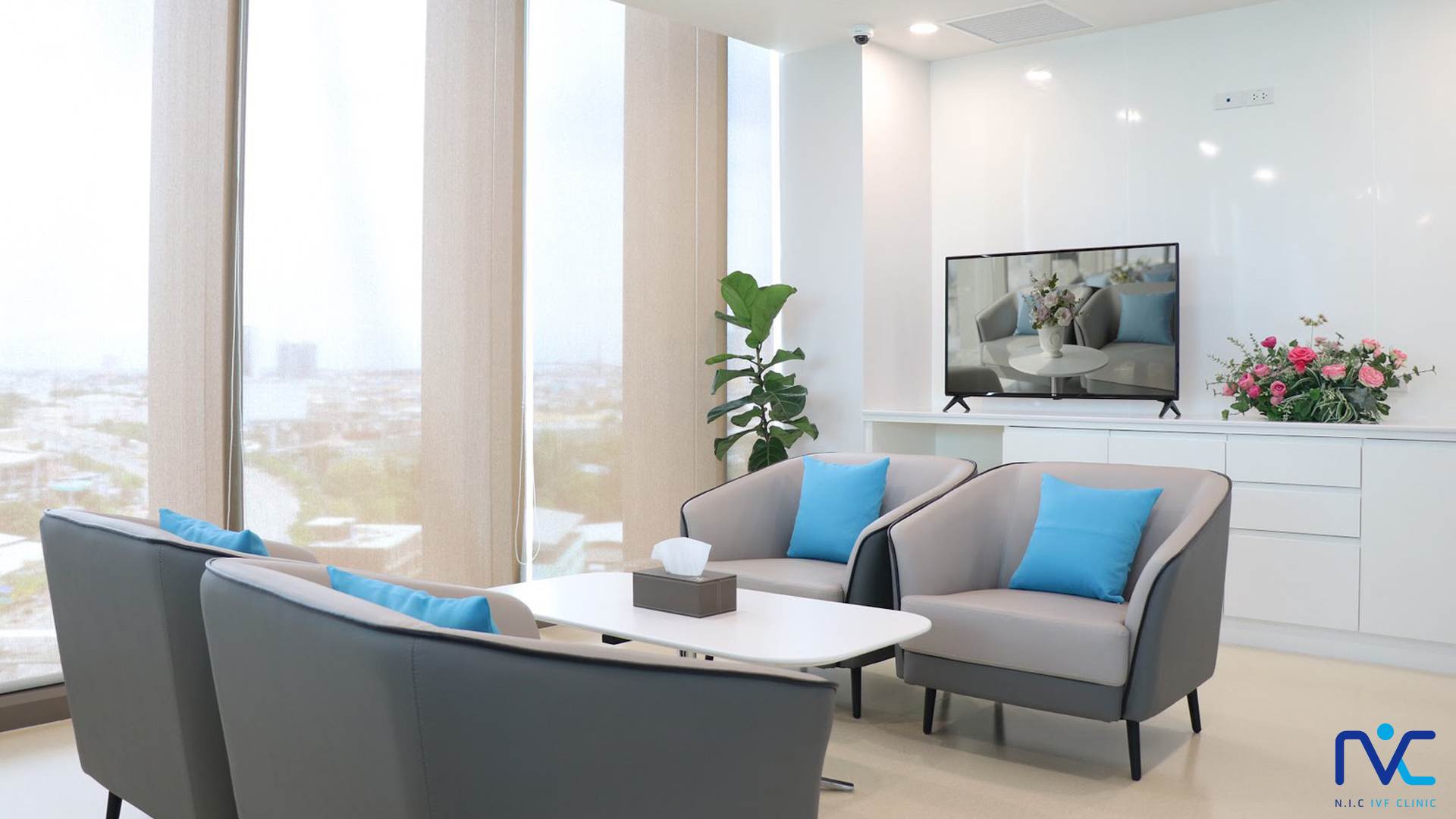FACILITIES
-
Lab


Embryology Laboratory

Andrology Laboratory

Cryopreservation Laboratory

Genetic Laboratory

Embryology Laboratory
N.I.C IVF Clinic's Embryo Laboratory has been certified according to the standard of ISO Class 6 or Cleanroom Class1,000 (Room with particle 0.5 Micron or larger but no more than 1,000 particles/1 cubic foot of air). There is an establishment of environmental control such as making sure to have appropriate temperature, humidity, and pressure. There is a HEPA filter to prevent dust and pollution, so the air is highly purified. We use Non-UV Light for the safety of embryos, and the air pressure is always Positive Pressure. At the entrance, there is an Air Shower to blow and clean the clothes of the staff before entering the laboratory. In addition, there is an Interlock system between the operating room and the Embryology laboratory which means the door can be opened only one side to prevent any contaminations from both areas. Air Shower at the entrance of the Embryology LaboratoryN.I.C IVF Clinic's Embryology Laboratory provides the following services; Oocyte Retrieval, ICSI (Intracytoplasmic Sperm Injection), Embryo Culture, Embryo Biopsy, Oocyte and Embryo Vitrification, and Embryo Transfer. All tools and equipment are well provided with modern technology in order to provide the highest qualified work for Embryo Laboratory.
Air Shower at the entrance of the Embryology LaboratoryN.I.C IVF Clinic's Embryology Laboratory provides the following services; Oocyte Retrieval, ICSI (Intracytoplasmic Sperm Injection), Embryo Culture, Embryo Biopsy, Oocyte and Embryo Vitrification, and Embryo Transfer. All tools and equipment are well provided with modern technology in order to provide the highest qualified work for Embryo Laboratory.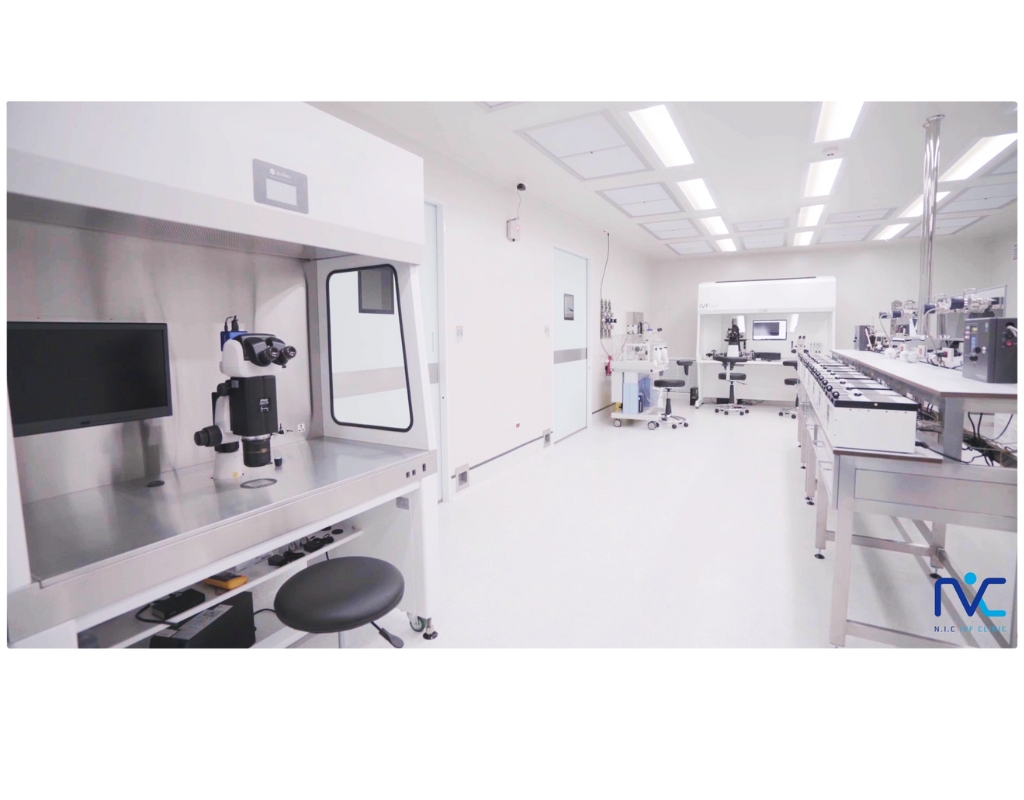 The equipment in Embryology LaboratoryOocyte RetrievalTransvaginal Ovum Aspiration is to retrieve eggs. The eggs will be delivered through a Pass box to the Embryo Culture room. The tubes that contain the eggs will be placed in Tube Warmer with the temperature at 37 degrees Celsius which is suitable for the eggs to maintain. After that, the specialist will examine the eggs in IVF Chamber at a temperature of 37 degrees Celsius. Moreover, we make sure to control the level of CO2 at 6%, so we can maintain the temperature and pH level in the environment to be as close as the body's
The equipment in Embryology LaboratoryOocyte RetrievalTransvaginal Ovum Aspiration is to retrieve eggs. The eggs will be delivered through a Pass box to the Embryo Culture room. The tubes that contain the eggs will be placed in Tube Warmer with the temperature at 37 degrees Celsius which is suitable for the eggs to maintain. After that, the specialist will examine the eggs in IVF Chamber at a temperature of 37 degrees Celsius. Moreover, we make sure to control the level of CO2 at 6%, so we can maintain the temperature and pH level in the environment to be as close as the body's IVF Chamber
IVF Chamber Tube Warmer to maintain the eggs in the Pass boxThe Embryo Culture room is located IVFtech in work station area that is free from any contaminations. We have a HEPA filter to circulate and filter the air, so the air is cleaned and purified for the eggs and embryos. Also, we maintain the temperature at 37 degrees Celsius.
Tube Warmer to maintain the eggs in the Pass boxThe Embryo Culture room is located IVFtech in work station area that is free from any contaminations. We have a HEPA filter to circulate and filter the air, so the air is cleaned and purified for the eggs and embryos. Also, we maintain the temperature at 37 degrees Celsius.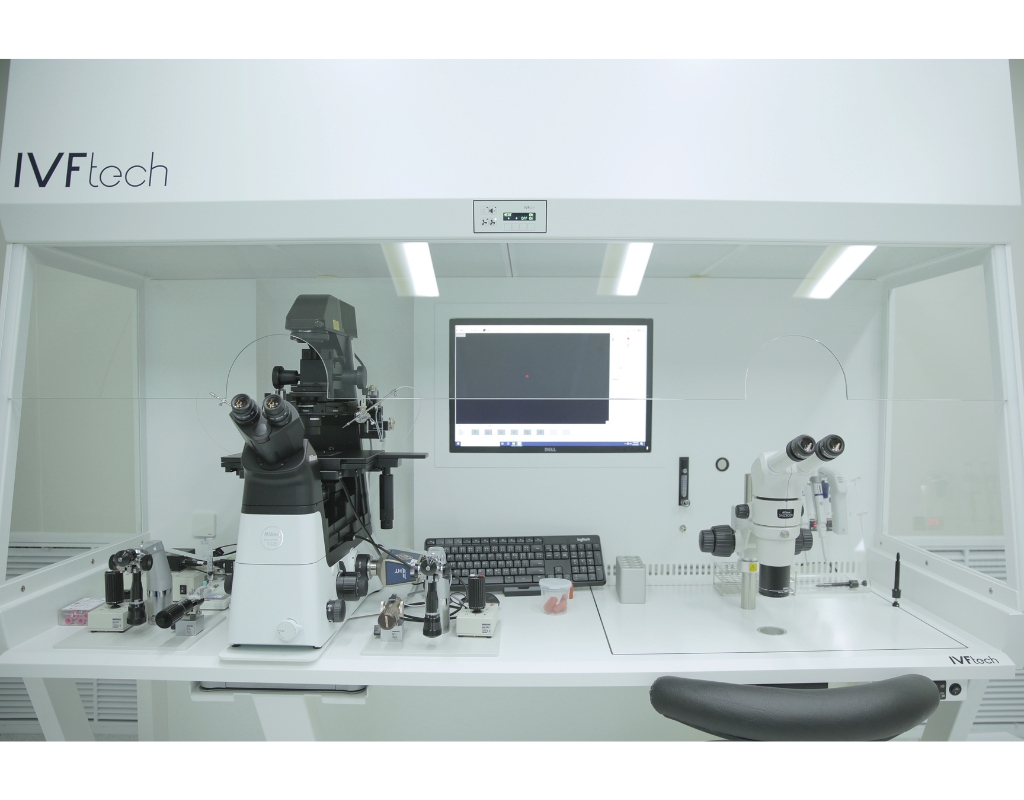 Work station in the Embryo Culture roomICSI (Intracytoplasmic Sperm Injection)In addition to regular ICSI, Oosight imaging has been used to inspect the oocyte's structure to visualize the meiotic spindle alignment in order to avoid injury or tearing of the oocyte during ovulation. Perform ICSI. Eggs fertilized with this technique have cell division and develop into healthy embryos.
Work station in the Embryo Culture roomICSI (Intracytoplasmic Sperm Injection)In addition to regular ICSI, Oosight imaging has been used to inspect the oocyte's structure to visualize the meiotic spindle alignment in order to avoid injury or tearing of the oocyte during ovulation. Perform ICSI. Eggs fertilized with this technique have cell division and develop into healthy embryos. The examination's result and the image of Meiotic Spindle will show on the screen in work station
The examination's result and the image of Meiotic Spindle will show on the screen in work station ICSI processEmbryo CultureThe Embryo Culture process takes place after sperm and eggs are conceived in the work station that has a suitable environmental control for embryos. We make sure that gas, temperature, light, nutritious, and pH levels are suitable for embryos until they reach Blastocyst stage. In general, this state happens 5-6 days after the eggs are retrieved.
ICSI processEmbryo CultureThe Embryo Culture process takes place after sperm and eggs are conceived in the work station that has a suitable environmental control for embryos. We make sure that gas, temperature, light, nutritious, and pH levels are suitable for embryos until they reach Blastocyst stage. In general, this state happens 5-6 days after the eggs are retrieved..jpg) Benchtop Incubator BT37Benchtop Incubator BT37 is an incubator that has suitable temperature, humidity, and pH levels for embryos. We can adjust the level of gas (Tri Gas) and temperature to be stable as quickly as possible. There is also a system for emergency batterie.Embryo TransferThe process of transferring embryos to the uterine cavity is performed in the clean room (Class 1,000). In addition, the process of embryo transfer through the catheter is done within a sterile cabinet that has HEPA filter to filter and purify the air. There is a system for air circulation and temperature control at 37 degrees Celsius.
Benchtop Incubator BT37Benchtop Incubator BT37 is an incubator that has suitable temperature, humidity, and pH levels for embryos. We can adjust the level of gas (Tri Gas) and temperature to be stable as quickly as possible. There is also a system for emergency batterie.Embryo TransferThe process of transferring embryos to the uterine cavity is performed in the clean room (Class 1,000). In addition, the process of embryo transfer through the catheter is done within a sterile cabinet that has HEPA filter to filter and purify the air. There is a system for air circulation and temperature control at 37 degrees Celsius.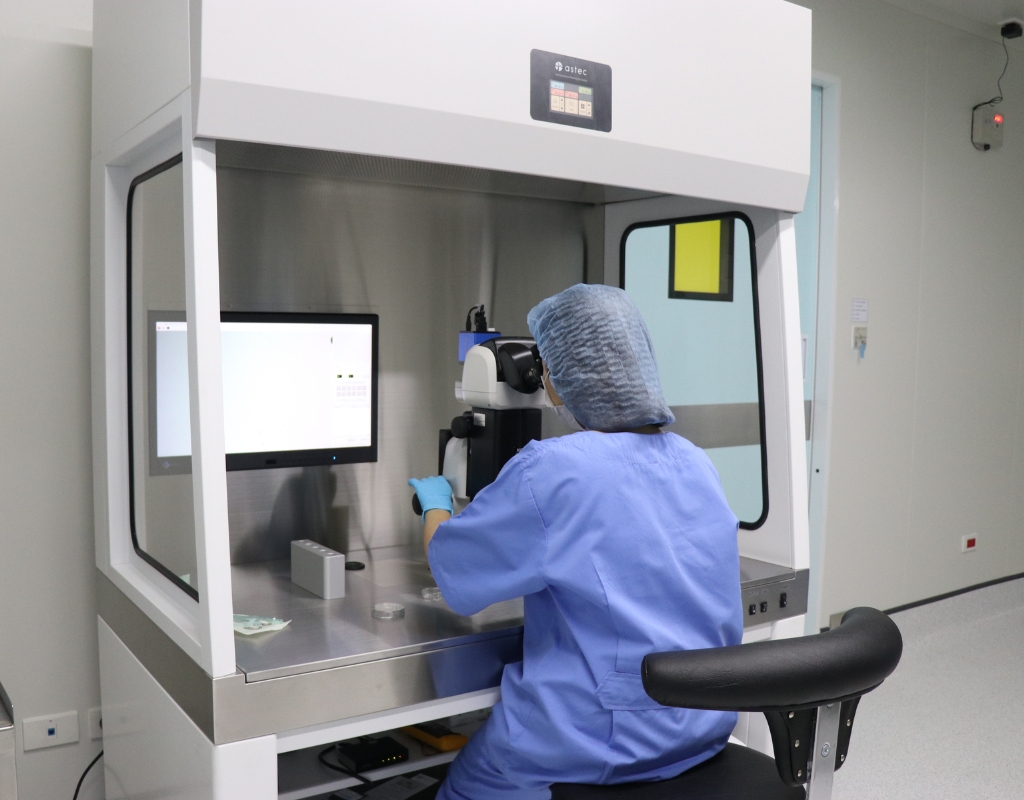 Sterile cabinet for containing embryos in the embryo transfer process
Sterile cabinet for containing embryos in the embryo transfer process
Andrology Laboratory
N.I.C IF Clinic's Andrology Laboratory has been certified according to ISO standard Class 7 or Cleanroom Class 10,000 (Room with particle 0.5 Micron or larger but no more than 10,000 particles/1 cubic foot of air). There is an establishment of environmental control such as making sure to have appropriate temperature, humidity, and pressure. There is a HEPA filter to prevent dust and pollution, so the air is highly purified. We also use Non-UV Lights for the safety of sperm.

Workstation inside Andrology Laboratory
N.I.C IVF Clinic's Andrology Laboratory provides these services:
- Semen Analysis
- Sperm freezing
- IUI
- Surgical Sperm Recovery: PESA, TESE
- DNA Fragment Index
- New technology for sperm selection is known as MACS Sperm (Magnetic Activated Cell Sorting Sperm)
Semen Analysis
Semen analysis of the quality of semen. It consists of visually examining the appearance of semen (color, smell, pH level number, and the ability to dissolve) and sperm count. movement and the shape of the sperm. The laboratory will measure with a specific instrument called Computer-aided sperm analysis, or CASA. Inside the CASA machine, there are cameras inside that help capture images of sperm that are motile and not motile. It was calculated with a computer program to obtain accurate sperm concentration and number of motile sperm. In addition, in the analysis of sperm morphology, a picture of the patient's sperm was recorded for each examination. And can show the shape of the analyzed sperm to the patient.
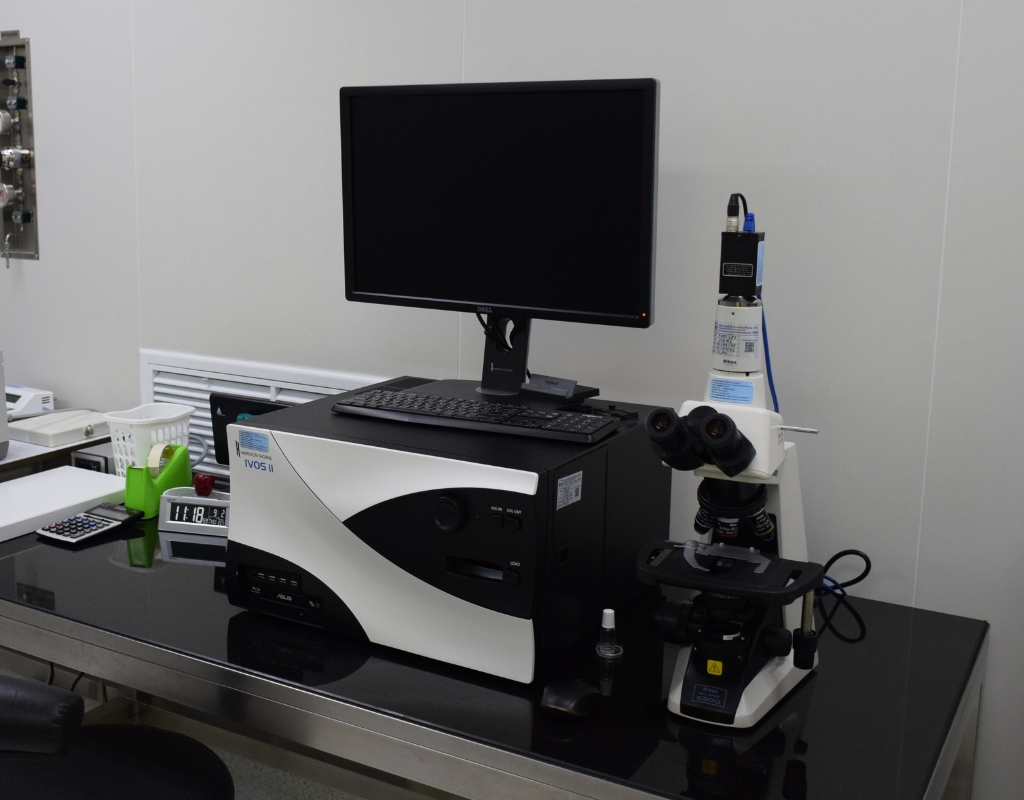
Computer-aided sperm analysis (CASA) machine
Halosperm G2
Sperm DNA fragmentation detection using Sperm Chromatin Dispersion (SCD) technique that is easy and accurate. Using a bright field microscope, the sperm that were stained with the solution were analyzed. Normal sperm without DNA damage are able to form halos around the head because the head contains a lot of DNA. Sperm without a circle surrounding the head are sperm that have broken or damaged DNA.
There are many causes of DNA fragmentation in sperm, such as the occurrence of oxidative stress, which is a condition in which sperm have too many free radicals. leading to changes in the shape and function of sperm causing DNA breakage Therefore, the degree of damage in the sperm DNA (Sperm DNA damage) will result in a decrease in the fertilization rate. Decreased embryo implantation rate and have a higher miscarriage rate.
Sperm DNA fragmentation

Sperm DNA fragmentation
MACS Sperm
It is a method for selecting healthy sperm (Non-Apoptotic sperm). Based on the principle that sperm that are dead or have DNA damage (Apoptotic Sperm), epidermal cells will change their properties, causing Phosphatidylserine (PS) to move out to the outer sperm epidermal cells. Which is an indicator that the sperm quality is not quality. MACS GMP Annexin V reagent binds to dead or DNA damaged sperm well. which is coated with a magnetic substance as a sucker will trap the dead sperm to stick tightly can't run through Therefore, only healthy sperm will pass through this magnetic field and be able to continue using ICSI.
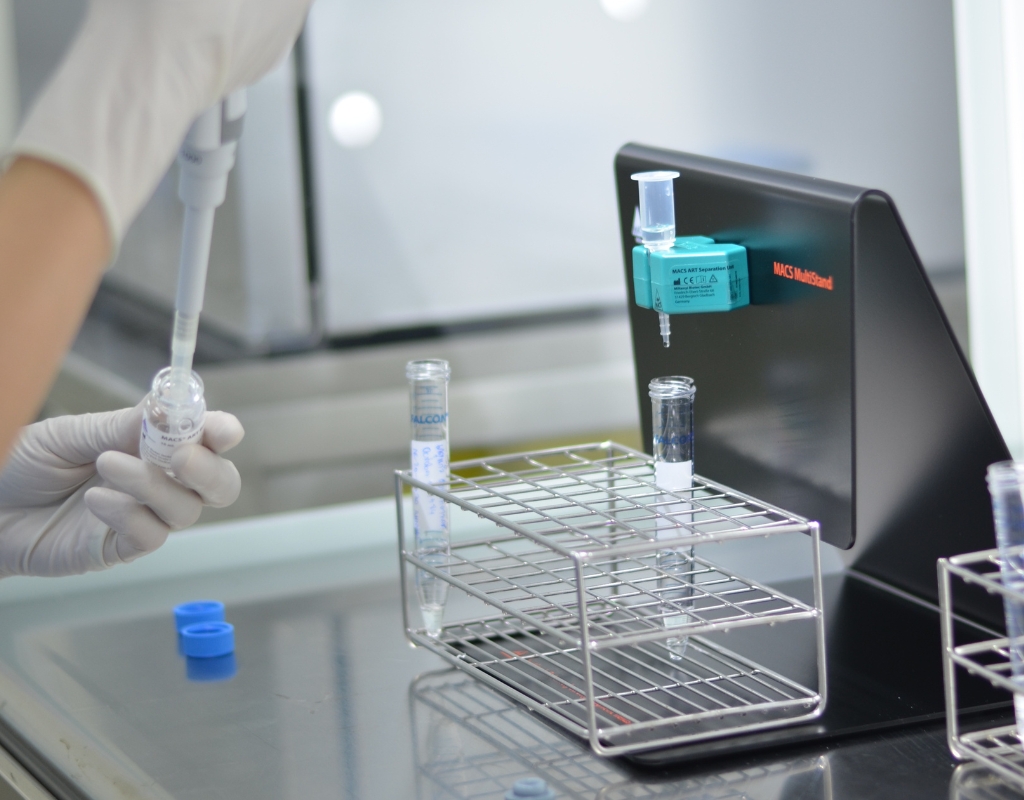
Magnetic bar and MACs GMP Annexin V set that is used for healthy sperm selection

Cryopreservation Laboratory
N.I.C IVF Clinic's Cryopreservation Laboratory is separated from Embryology
Laboratory and Andrology Laboratory. Cryopreservation Laboratory has a system controlling pressure, temperature, and humidity. The laboratory also has been certified according to ISO Class 7 standard or Cleanroom Class 10,000 (Room with particle 0.5 Micron or larger but no more than 10,000 particles/1 cubic foot air). Furthermore, there is a security check system to control people who come in and out the laboratory. The storages for sperm, eggs, and embryos are to be locked at all time for safety. In addition, there is an Oxygen Sensor machine
in the room to check the level of Oxygen (O2). If the level of Oxygen is lower than the standard and is dangerous to the staff, the machine will make an alarm right away.
The security system of the Cryopreservation room
Oxygen Sensor
Oocyte and Embryo Vitrification
The technology of Oocyte and Embryo Vitrification is to use cryoprotectants with high intensity to prevent crystallization that can be very harmful to embryos. Using liquid Nitrogen, the temperature will go down as quickly as possible to -196 degrees Celsius. This process protects embryos from any contaminations that might come with liquid Nitrogen. We actually can keep the embryos in storage for a long time. Most importantly, we keep noninfectious eggs and embryos separated from the infectious ones to make sure there is no contamination. The service recipient can be assured that there is absolutely no contamination. For example, we separated the container with Hepatitis B from the normal ones. Therefore. the patients can be very sure in every process because of our highest safety policy.
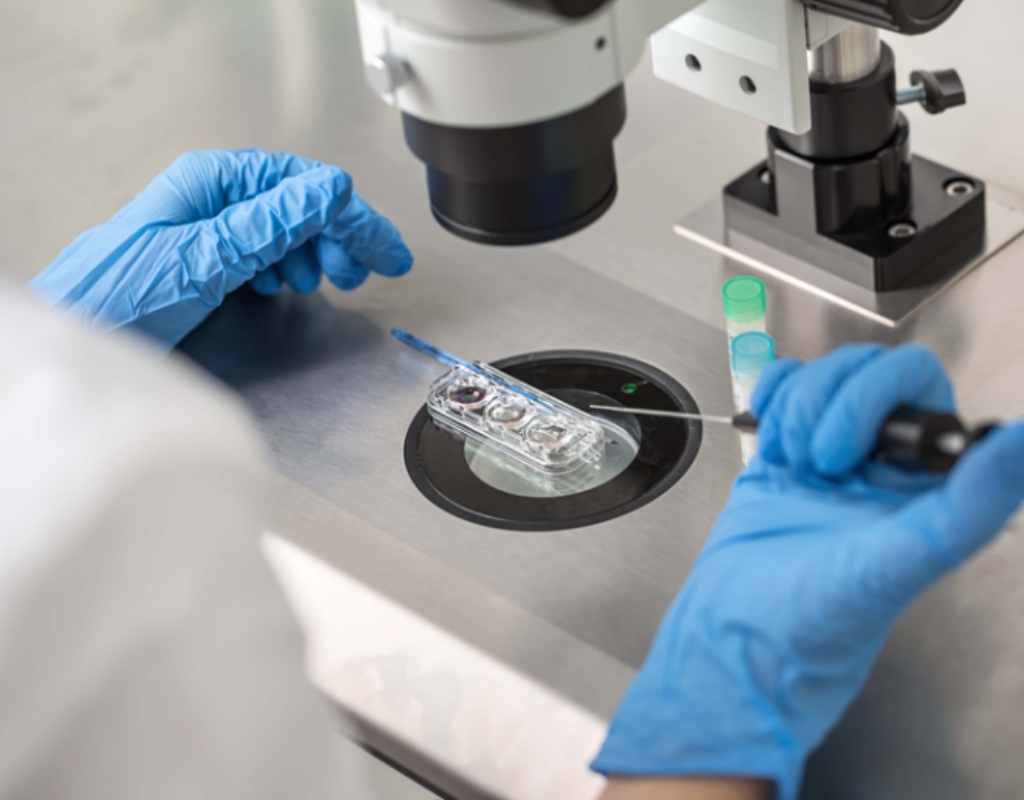
The technology of Oocyte and Embryo Vitrification

Separate frozen eggs and embryo containers are infectious and non-infectious.
Sperm Freezing
The technique for preserving sperm under cryopreservation in a tank of liquid nitrogen at -196 degrees Celsius. It can be done by releasing water from the cell in order to prevent crystallization because crystallization can kill sperm and decrease the temperature by using Cryoprotectant Agents (CPAs). This technique can help us keep sperm for a very long time, and we also separate non-infectious containers from infectious ones.

Storing frozen sperm in frozen sperm storage tanks

Sperm Freezing Equipment

Genetic Laboratory
N.I.C IVF Clinic's Genetic Laboratory has been certified according to ISO standard Class 7 or Cleanroom Class 10,000 (Room with particle 0.5 Micron or larger but no more than 10,000 particles/1 cubic foot air). There is an establishment of environmental control such as making sure to have appropriate temperature, humidity, and pressure. We use a HEPA filter to prevent dust and pollution, so the air in the room is highly purified. N.I.C IVF Clinic's Genetic Laboratory provides the following services; increasing the amount of DNA with PCR and Whole Genome Amplification (WGA)techniques, embryo chromosome screening with Next Generation Sequencing (NGS), Single gene disorder examination by using Direct genetic testing method, and using mini sequencing and Indirect genetic testing which come from the method of Linkage analysis.
Embryo Biopsy in order to find out genetic disorders.
Nowadays, Embryo Biopsy is usually performed during the Blastocyst stage of the embryo. The procedure is done by removing 4-5 cells from Trophectoderm or the part that will develop as the placenta during the pregnancy, and this process has no effect on the development of the embryo. Laser sets (LYKOS) and an Inverted Microscope are used in the lab, which is known to be very safe with no impact on the development of the embryo.

How Trophectoderm is being removed with laser. The yellow circle represents the laser's radius.
Preimplantation Genetic Testing: PGT
Currently, the technology of Preimplantation Genetic Testing (PGT) has improved tremendously. This testing was done for the first time in 1980 by using the PCR method to increase the amount of DNA in the diseases that can be inherited through sex chromosomes. Due to some technical limitations, the testing could only reveal the gender of the embryo but did not identify genetic or chromosome disorders. In addition, choosing to remove embryos in the gender that did not show any symptoms of the disease or being a carrier may lose the other gender that could either be completely normal or have a serious disease. So, the abnormalities of each embryo cannot be found. Therefore, there must be a specific testing technique that can identify gender, genetic, and chromosome disorders. Nowadays, Preimplantation Genetic Testing has been developed to increase the amount of DNA and more precise testing techniques such as Comparative Genomic Hybridization (CGH), Next Generation Sequencing (NGS), real time PCR, and Karyomapping. Now, the Preimplantation Genetic Testing technique that is commonly used is Next Generation Sequencing (NGS).
Next Generation Sequencing (NGS) is a new technology that identifies base sequencing faster and can be used for embryo chromosome testing which covers 24 chromosomes all at once with 95-97% correct results. Presently, because we perform embryo testing during Blastocyst, we can obtain more cells and then gain higher precise outcomes. Besides testing for having less or more chromosomes, we can look for segmental aneuploidy in chromosomes while old techniques such as FISH and CGH cannot deliver the same results. Moreover. NGS technique can increase the success rate in pregnancy and reduce miscarriage to 50%
.jpg)
Next Generation Sequencing machine (NGS)
-
Rest area
-
Operating room
-
Consult room
-
VIP room
